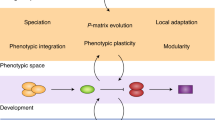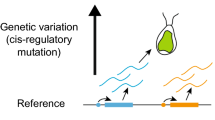Abstract
Characterizing and comparing the covariance or correlation structure of phenotypic traits lies at the heart of studies concerned with multivariate evolution. I describe an approach that represents the geometric structure of a correlation matrix as a type of proximity graph called a Correlation Proximity graph. Correlation Proximity graphs provide a compact representation of the geometric relationships inherent in correlation matrices, and these graphs have simple and intuitive properties. I demonstrate how this framework can be used to study patterns of phenotypic integration by employing this approach to compare phenotypic and additive genetic correlation matrices within and between species. I also outline a graph-based method for testing whether an inferred correlation proximity graph is one of a number of possible models that are consistent with a “soft” biological hypothesis.






Similar content being viewed by others
References
Bookstein, F. L., Chernoff, B., Elder, R., Humphries, J., Smith, G., & Strauss, R. (1985). Morphometerics in evolutionary biology. Philadelphia, PA: Academy of Natural Sciences.
Chernoff, B., & Magwene, P. M. (1999). Morphological integration: Forty years later. In: E. C. Oslon & R. C. Miller (Eds.), Morphological integration (pp. 316–360). Chicago: University of Chicago.
Cheverud, J. M. (1982). Phenotypic, genetic, and environmental morphological integration in the cranium. Evolution, 36, 499–516.
Drton, M., & Perlman, M. D. (2004). Model selection for Gaussian concentration graphs. Biometrika, 91, 591–602.
Dunn, L. C. (1928). The effect of inbreeding on the bones of the fowl. Bulletin Storrs Agricultural Experiment Station, 152, 1–112.
Gabriel, K. R., & Sokal, R. R. (1969). A new statistical approach to geographic variation analysis. Systematic Zoology, 18, 259–278.
Hansen, T. F. (2003). Is modularity necessary for evolvability? Remarks on the relationship between pleiotropy and evolvability. Biosystems, 69, 83–94.
Higham, N. J. (2002). Computing the nearest correlation matrix–a problem from finance. IMA Journal of Numerical Analysis, 22, 329–343.
Jaromczyk, J. W., & Toussaint, G. T. (1992). Relative neighborhood graphs and their relatives. Proceedings of the IEEE, 80, 1502–1517.
Kohn, L. A. P., & Atchley, W. R. (1988). How similar are genetic correlation structures data from mice and rats. Evolution, 42, 467–481.
Krzanowksi, W. J. (1988). Principles of multivariate analysis. Oxford: Clarendon Press.
Lande, R., & Arnold, S. J. (1983). The measurement of selection on correlated characters. Evolution, 37, 1210–1226.
Lauritzen, S. L. (1996). Graphical models. Oxford: Oxford University Press.
Magwene, P. M. (2001). New tools for studying integration and modularity. Evolution, 55, 1734–1745.
Magwene, P. M., & Kim, J. (2004). Estimating genomic coexpression networks using first-order conditional independence. Genome Biology, 5, 1–100.
Matula, D. W., & Sokal, R. R. (1980). Properties of gabriel graphs relevant to geographic variation research and clustering of points in the plane. Geographic Analysis, 12, 205–222.
Olson, E. C., & Miller, R. L. (1958). Morphological integration. Chicago: University of Chicago Press.
O’Quigley, T. G. (1993). A geometric interpretation of partial correlation using spherical triangles. American Statistician, 47, 30–32.
Phillips, P. C., & Arnold, S. J. (1999). Hierarchical comparison of genetic variance-covariance matrices. I. Using the flury hierarchy. Evolution, 53, 1506–1515.
Wagner, G. P., & Altenberg, L. (1996). Complex adaptations and the evolution of evolvability. Evolution, 50, 967–976.
Wagner, G. P., Pavlicev, M., & Cheverud, J. M. (2007). The road to modularity. Nature Reviews Genetics, 8, 921–931.
Whittaker, J. (1990). Graphical models in applied mathematical multivariate statistics. Chichester: Wiley.
Wickens, T. D. (1995). The geometry of multivariate statistics. Hilldales: Lawrence Erlbaum Associates.
Wille, A., & Buhlmann, P. (2006). Low-order conditional independence graphs for inferring genetic networks. Statistical Applications in Genetics and Molecular Biology 5: Article 1.
Wille, A., Zimmermann, P., Vranova, E., Furholz, A., Laule, O., Bleuler, S., Hennig, L., Prelic, A., von Rohr, P., Thiele, L., Zitzler, E., Gruissem, W., & Buhlmann, P. (2004). Sparse graphical Gaussian modeling of the isoprenoid gene network in Arabidopsis thaliana. Genome Biology, 5, R92.
Wright, S. (1932). General, group and special size factors. Genetics, 15, 603–619.
Young, N. M., & Hallgrimsson, B. (2005). Serial homology and the evolution of mammalian limb covariation structure. Evolution, 59, 2691–2704.
Zelditch, M. L. (1987). Evaluating models of developmental integration in the laboratory rat using confirmatory factor analysis. Systematic Zoology, 36, 368–380.
Author information
Authors and Affiliations
Corresponding author
Rights and permissions
About this article
Cite this article
Magwene, P.M. Using Correlation Proximity Graphs to Study Phenotypic Integration. Evol Biol 35, 191–198 (2008). https://doi.org/10.1007/s11692-008-9030-y
Received:
Accepted:
Published:
Issue Date:
DOI: https://doi.org/10.1007/s11692-008-9030-y




